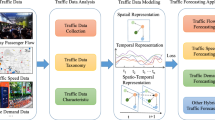Abstract
Benchmarking spatiotemporal database systems requires the definition of suitable datasets simulating the typical behavior of moving objects. Previous approaches for generating spatiotemporal data do not consider that moving objects often follow a given network. Therefore, benchmarks require datasets consisting of such “network-based” moving objects. In this paper, the most important properties of network-based moving objects are presented and discussed. Essential aspects are the maximum speed and the maximum capacity of connections, the influence of other moving objects on the speed and the route of an object, the adequate determination of the start and destination of an object, the influence of external events, and time-scheduled traffic. These characteristics are the basis for the specification and development of a new generator for spatiotemporal data. This generator combines real data (the network) with user-defined properties of the resulting dataset. A framework is proposed where the user can control the behavior of the generator by re-defining the functionality of selected object classes. An experimental performance investigation demonstrates that the chosen approach is suitable for generating large data sets.
Similar content being viewed by others
References
R.K. Ahuja, T.L. Magnanti, and J.B. Orlin. Network Flows: Theory, Algorithms, and Applications, Prentice-Hall, 1993.
T. Brinkhoff. “Requirements of traffic telematics to spatial databases,” in Proceedings 6th International Symposium on Large Spatial Databases, Hong Kong, China. Lecture Notes in Computer Science, Vol. 1651:365-369, 1999.
Bundesanstalt für Straßenwesen, Bundesrepublik Deutschland. http://www.bast.de/
J. Gray. The Benchmark Handbook, Morgan-Kaufman, 1991.
O. Günther, V. Oria, P. Picouet, and J.-M. Saglio, M. Scholl. “Benchmarking spatial joins á la carte,” in Proceedings 10th International Conference on Scientific and Statistical Database Management, Capri, Italy, pp. 32-41, 1998.
A. Guttman. “R-trees: A dynamic index structure for spatial searching,” in Proceedings ACM SIGMOD International Conference on Management of Data, Boston, MA, pp. 47-57, 1984.
Integrating Spatial and Temporal Databases, Seminar, Schloss Dagstuhl, Wadern, Germany, November 22–27, 1998.
H.-P. Kriegel, M. Schiwietz, R. Schneider, and B. Seeger. “Performance comparison of point and spatial access methods,” in Proceedings 1st Symposium on the Design and Implementation of Large Spatial Databases, Santa Barbara, CA. Lecture Notes in Computer Science, Vol. 409:89-114, 1989.
MapInfo Corporation. MapInfo Professional TM : Reference Manual, 1995.
H. Mehl. “Mobilfunk-Technologien in der Verkehrstelematik,” Informatik-Spektrum, Vol. 19:183-190, 1996.
Oracle Corporation. Oracle® Spatial, User's Guide and Reference, Release 8.1.7, 2000.
D. Pfoser and Y. Theodoridis. “Generating semantics-based trajectories of moving objects,” in Proceedings International Workshop on Emerging Technologies for Geo-Based Applications, Ascona, Switzerland, pp. 59-76, 2000.
Rand McNally. The Road Atlas: United States, Canada & Mexico, 2001.
J.-M. Saglio and J. Moreira. “Oporto: A realistic scenario generator for moving objects,” in Proceedings DEXA Workshop on Spatio-Temporal Data Models and Languages, Florence, Italy, pp. 426-432, 1999. An extended version is published in: GeoInformatica Vol. 5(1):71–93, 2001.
T. Sellis. “Research issues in spatio-temporal database systems,” in Proceedings 6th International Symposium on Large Spatial Databases, Hong Kong, China, Lecture Notes in Computer Science, Vol. 1651:5-11, 1999.
B. Seeger, M. Egenhofer, J. Gray, S. Leutenegger, and D. Papadias. “Seeking the truth—curses and blessings of experiments,” Panel of the 7th International Symposium on Spatial and Temporal Databases, 2001.
Spatial and Temporal Databases, 7th International Symposium, Redondo Beach, CA, July 12–15, 2001.
Spatio-Temporal Database Management, Workshop, Edinburgh, Scotland, September 10–11, 1999.
Spatio-Temporal Data Models and Languages, Workshop, Florence, Italy, August 30–31, 1999.
M. Stonebraker, J. Frew, K. Gardels, and J. Meredith. “The SEQUOIA 2000 storage benchmark,” in Proceedings ACM SIGMOD International Conference on Management of Data, Washington, DC, pp. 2-11, 1993.
Y. Theodoridos and M. Nascimento. “Generating spatiotemporal datasets on the WWW,” ACM SIGMOD Record, Vol. 29(3):39-43, 2000.
Y. Theodoridis, J.R.O. Silva, and M.A. Nascimento. “On the generation of spatiotemporal datasets,” in Proceedings 6th International Symposium on Large Spatial Databases, Hong Kong, China, Lecture Notes in Computer Science, Vol. 1651:147-164, 1999.
U.S. Government Information and Maps Department. The Map Collection—TIGER/Line Files, http://www.lib.ucdavis.edu/govdoc/MapCollection/tiger.html.
J. Zobel, A. Moffat, and K. Ramamohanarao. “Guidelines for presentation and comparison of indexing techniques,” ACM SIGMOD Record, Vol. 25(3):10-15, 1996.
3sat: Raus aus dem Stau, Ein nano-Schwerpunkt. http://www.3sat.de/nano/bstuecke/18130/index.html.
Author information
Authors and Affiliations
Rights and permissions
About this article
Cite this article
Brinkhoff, T. A Framework for Generating Network-Based Moving Objects. GeoInformatica 6, 153–180 (2002). https://doi.org/10.1023/A:1015231126594
Issue Date:
DOI: https://doi.org/10.1023/A:1015231126594




